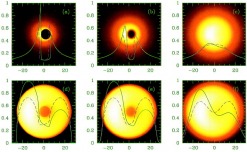Using the SMA as a VLBI station, and probing the SMBH in Sgr A*
A unique but challenging opportunity exists to image the immediate neighborhood of the black hole in the center of our galaxy (SgrA*) at a resolution comparable to the size of the event horizon. The image of synchrotron radiation from gas in the black hole's accretion disk is highly distorted because of the strong field effects of general relativity. Theoretical calculations show that the size of the distorted image (with a central ``shadow'') is about 50 micro-arcseconds and depends on the spin of the black hole as well as the opacity and distribution of the emitting gas. Imaging the near neighborhood of a black hole would be an astonishing accomplishment for all of astronomy. VLBI imaging can now only be done routinely to wavelengths as short as 3 mm. The opportunity exists to push this threshold to 1 mm wavelength and 20 micro-arcseconds resolution (with baselines of up to 5000 km). Such high resolution is only available at radio/millimeter wavelengths in the reasonably near future. The part of the spectrum near 1 mm wavelength is the ideal place to image the shadow of the black hole because the flux density is high, the emission is relatively unaffected by scattering in the intervening medium, and the opacity is small enough to observe close to the event horizon.
We aim to provide the Submillimeter Array (SMA) with a phased array processor, which will turn the SMA into a single aperture telescope with the equivalent area of the entire array. The SMA would also be equipped with a VLBI recording interface. This capability will allow the SMA to participate in VLBI observations. The SMA has fiber connections to the CSO and JCMT observatories and the phased array system could include their signals coherently as well, providing the equivalent collecting area of a 25 m diameter telescope on Mauna Kea. Thus, the SMA has the potential to become the center of submillimeter wavelength VLBI on Mauna Kea, providing the longest baselines critical for imaging.
Simulated submillimeter VLBI image of a super massive black hole

Theoretical calculations of the shadow of the black hole in Sgr A* made by Falke, Melia and Agol (2000). (a) The image (intensity) of Sgr A* for a maximally rotating black hole surrounding by radiating gas in free fall, i.e., with emissivity inversely proportional to the square of the distance from the center. The solid and dotted lines are cross sections of intensity along x and y axes. The vertical scale is intensity in arbitrary units. The horizontal scale gives the spatial dimension of the image in units of the gravitational radius of about 5 microarcseconds. Panels (b) and (c) show the simulated VLBI observations at 0.6 mm and 1.3 mm respectively, which include the blurring effects of the plasma inhomogeneities. Panel (d) shows the intensity image for a non-rotation black hole from a medium of uniform emissivity from Keplerian shells. Panels (e) and (f) are the simulated measurements for 0.6 and 1.3 mm wavelength.